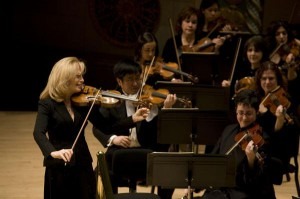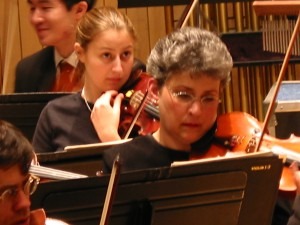
Emmanuelle Boisvert tuning the Detroit Symphony Orchestra
The orchestra is assembled, the concertmaster comes to the stage, turns his back on the audience and signals the oboist. A pure clear note sounds and then lots of other notes. What is this all about?
Before the players come onto the stage, they spend time warming up, playing scales to get their fingers limbered up, tries a few high notes out and then take their seats on stage. When the concertmaster calls for the oboist’s note, this is the first time that the orchestra, as an ensemble, tunes itself. When they were warming up backstage, each player was approximately in tune, but it’s only when everyone’s on stage, together, in the hall, that they are able to tune as an orchestra.

Andrew Price, oboist
The oboe is used because it has a bright, clear tone that can be easily heard throughout the orchestra. If there’s no oboe being used in the first piece, the clarinet sounds the note. If there’s no woodwinds, then the concertmaster pre-tunes offstage and becomes the tuning standard on-stage. When you have an instrument that cannot be easily tuned, such as a piano or an organ, they give their note to the oboe who then sounds it for the rest of the orchestra. Simple!
First, it’s the woodwinds and brass who tune, then it’s time for the strings. Although it seems rather token when you’re sitting in the audience, this tuning process is important and the concertmaster has to listen carefully to each section as they match the pitch of the oboe. If the concertmaster isn’t happy with the sound of a section, he will ask them to tune again.

Skidmore College Orchestra – tuning with the fine tuning peg
For the string section, they can tune their instruments two different ways: with the tuning pegs at the end of fingerboard, or with the fine tuning peg attached to the violin tailpiece
So, listen carefully the next time you’re in the audience. If you listen to one particular section, such as the flutes or the cellos, you can hear them make the careful adjustments necessary for the perfect orchestral sound.



